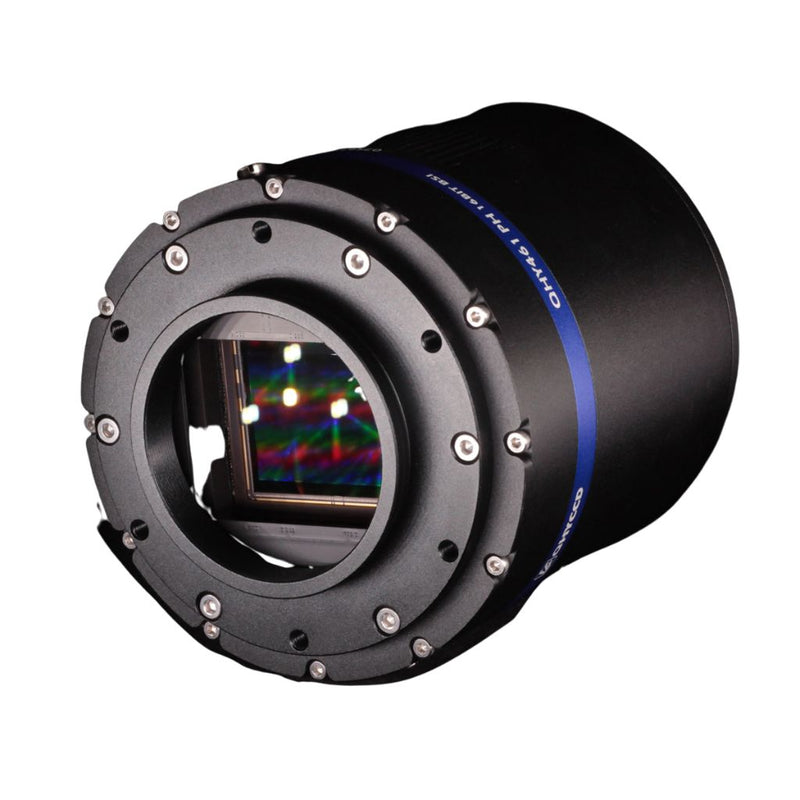New Model Designed Specifically for Astrophotography
The QHY461M-PH is a new photographic version of the larger scientific QHY461M-PRO model. The photographic version QHY461M-PH is housed in a more compact body with fewer scientific features than its larger counterpart. For example, the QHY461M-PH does not have the option of a 2x10GB fiber optic interface, external triggers, GPS timing or programmable FPGA. Otherwise, its performance is essentially identical to the scientific models when they are operated with USB 3.0. The primary benefit of the QHY461M-PH is that it provides all the features and performance essential to astrophotography at a significantly lower price than the scientific models.
High Resolution Scientific CMOS with 102 Megapixels
The QHY461M-PH uses a Sony IXM461 Exmore R scientific CMOS sensor with similar architecture as the larger IMX411. The QHY461M-PH has 102 Megapixels in a 11656 x 8742 array with 3.76um pixels. The IMX461 is back-illuminated for high QE and dynamic range. The sensor size is 44mm x 33mm, 55mm diagonal.
Native 16-bit A/D, 65536 levels
The IMX461 is also the world's first scientific CMOS sensor with native 16-bit A/D on-chip. The output is real 16-bits with 65536 levels. Most CMOS sensors are 12-bit or 14-bit. This means that the conversion ratio cannot achieve 1e-/ADU and weak signals are not very highly sampled. Photometric measurements of low signals in such case are not as accurate. Some cameras combine two 12-bit outputs to create 16-bit images, but the actual number of levels is still 4096 x 2 = 8192 levels, significantly less than native 16-bits. Compared to cameras with these other sensors, the QHY461-PH yields higher sample resolution and the system gain will be less than 1e-/ADU with no sample error noise and very low read noise.
Ultra Low Read Noise, 1 Electron at High Gain
The QHY461M-PH has only one electron of read noise at high gain and 1 FPS (16-bit), 2 FPS (8-bit) high readout speed. One electron of read noise means the camera can achieve a SNR>3 at only 3 to 4 photons. This is perfect performance when conditions are photon limited, i.e., short exposures, narrow band imaging, etc., making this large area sensor ideal for sky surveys and time domain astronomy.
Back-Illuminated, 90% QE, Low Dark Current
The QHY461M-PH sensor is back-illuminated resulting in extraordinarily high quantum efficiency and has extremely low dark current using SONY's Exmor BSI sCMOS technology. This means the camera is not only ideal for short exposures due to its high sensitivity and low read noise, but is also ideal for long exposures where dark current noise often dominates. To further reduce the dark current noise, the QHY461M-PH incorporates QHYCCD's proprietary thermal noise reduction technology and two-stage thermoelectric cooling to reduce the temperature of the sensor.
Full Well Capacity of 50ke- in Standard Mode, Up to 720ke- in Extended Mode
Another benefit of the back-illuminated CMOS structure is improved full well capacity. This is particularly helpful for sensors with small pixels. Even with unbinned 3.76um pixels the QHY461M-PH has a full well capacity 50ke-. When binned 2x2 to 7.5um the full well is 204ke- and when binned 3x3 to 11um the full well is 408ke-. The QHY461M-PH also makes available several read modes of the sensor, including an Extended Full Well Mode. In extended mode the full well capacity is 80ke- unbinned, 320ke- binned 2x2 and 720ke- binned 3x3.
Zero Amplify Glow
The QHY461-ph has zero amplifier glow, even in long exposures.
True Raw Data
Many DSLR cameras have a RAW image output but typically it is not completely RAW. Some evidence of noise reduction and hot pixel removal is still visible on close inspection. This can have a negative effect on the image for astronomy such as the “star eater” effect. However, QHY cameras offer TRUE RAW IMAGE OUTPUT and produces an image comprised of the original signal only, thereby maintaining the maximum flexibility for post-acquisition astronomical image processing programs and other scientific imaging applications.
Anti-Dew Technology
Based on almost 20-years of cooled camera design experience, the QHY461M-PH fully implements frost and dew control solutions. The optical window has a built-in dew heater and the chamber is protected from internal humidity condensation. An electric heating board for the chamber window can prevent the formation of dew on the outside of the window and the sensor itself is kept dry with our desiccant tube socket design for control of humidity within the sensor chamber.
Advanced Features
Reboot the camera with power off and on
The camera is designed to use the +12V to reboot the camera without disconnecting and reconnecting the USB interface. This means that you can reboot the camera simply by shutting down the +12V and then powering it back on. This feature is very handy for remote controlling the camera in an observatory. You can use a remotely controlled power supply to reboot the camera. There is no need to consider how to reconnect the USB in the case of remote control.
Random thermal noise suppression function
Certain types of thermal noise can change with time in back-illuminated CMOS cameras. This thermal noise has the characteristic of fixed position thermal noise but the value is not related to the exposure time. Instead, each frame appears to have its own characteristics, making it difficult to remove. The QHY461M-PH uses an innovative proprietary suppression technology that can significantly reduce the level of such random thermal noise.
Optimizing USB Traffic to Minimize Horizontal Banding
It is common characteristic of CMOS sensors to contain some horizontal banding. Normally, random horizontal banding can be removed with multiple frame stacking so it does not affect the final image. However, periodic horizontal banding is not removed with stacking so it may appear in the final image. By adjusting the USB traffic in Single Frame mode or Live Frame mode, you can adjust the frequency of the CMOS sensor driver, optimizing the frequency at which horizontal banding is suppressed. This optimization is very effective at removing the periodic banding in most situations.


















